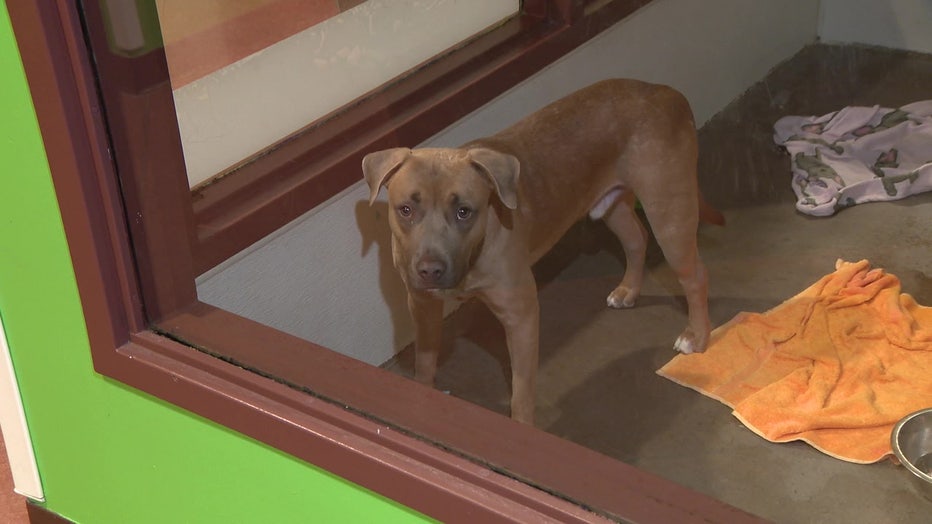What is dog flu, and what pet owners should be on the lookout for this winter

Maricopa County animal shelter dealing with dog flu
It's well known that humans can catch the flu, and that is also the same case for dogs. FOX 10's Danielle Miller has more on canine influenza.
PHOENIX - While many people are currently suffering from the flu, humanity's four-legged friends are also being hit hard.
Here's what you should know about Canine Influenza, also known as "Dog Flu."
What is it?
According to the Centers for Disease Control and Prevention, Canine Influenza is a contagious respiratory disease in dogs that is caused by a specific type of flu virus that is known to infect dogs.
What are the symptoms of dog flu?
The signs of dog flu, according to the CDC, include:
- Cough
- Runny nose
- Fever
- Lethargy, or a lack of energy and enthusiasm
- Eye discharge
- Reduced appetite
"The severity of illness associated with canine flu in dogs can range from no signs to severe illness resulting in pneumonia and sometimes death," read a portion of the website.
"Canine Influenza is very similar to what we get when we have the flu," said Kim Powell with Maricopa County Animal Care & Control. "They're just uncomfortable. Flu is not fun for anyone."
Please consult with your veterinarian if your dog shows the symptoms mentioned above.
How does it spread?
According to the CDC, dog flu is spread mainly among dogs through respiratory droplets produced during coughing and sneezing from infected dogs, or through contact with contaminated surfaces.
"If you see one of your dogs coughing or sneezing more, separate your dogs, if you can," said Powell. "Obviously, if they're already together, they might catch it, but Canine Influenza isn't necessarily very dangerous."
Can it spread to humans?
According to experts, it's very unlikely.
"To date, there is no evidence of spread of canine influenza viruses from dogs to people and there has not been a single reported case of human infection with a canine influenza virus in the U.S. or worldwide," read a portion of the CDC's website.
How long does it take for dogs to recover from dog flu?
According to the CDC, most dogs recover within two to three weeks, but some dogs may develop secondary bacterial infections, which may lead to more severe illness and pneumonia.
"The severity of illness associated with canine flu in dogs can range from no signs to severe illness resulting in pneumonia and sometimes death," read a portion of the website.
Powell says if symptoms don't clear up, a pet owner should take their dog in to be tested, because it could be far worse than the flu.
"Distemper is a very deadly disease," said Powell. "It has similar symptoms to the flu in canines, as well as any upper respiratory illnesses. The difference is it doesn't get better over time. It g ets worse."
Wait. Death from dog flu?
Officials with the CDC say while deaths can happen, the "percentage of dogs infected with this disease that die is very small"
How is dog flu treated?
Treatment, according to the CDC, largely consists of keeping a dog hydrated and comfortable, while it body mounts an immune response to the infection.
"In the milder form of the disease, this care may include medication to make your dog be more comfortable and fluids to ensure that your dog remains well-hydrated. Broad spectrum antibiotics may be prescribed by your veterinarian if a secondary bacterial infection is suspected," read a portion of the website.
Is there a shot for dog flu?
Yes, according to the CDC.
"Vaccines to protect dogs against both H3N8 and H3N2 canine flu are available in the United States," read a portion of the website.
For information about the vaccines, consult with your veterinarian.
Read More Explainer Stories
- What is nuclear fusion? Recent advance in research could be a clean-energy breakthrough
- Romance scams: What you should know about the scheme to defraud people
- Rabies: What is it, how it’s transmitted, and do you need a vaccine
Read More Pets and Animals Stories
- Pit bull helps owner cross icy Nebraska driveway
- Stuck puppy rescued from a window at a high-end London store
- Dog abandoned at Orlando hotel reunited with family 7 years after going missing in Texas


